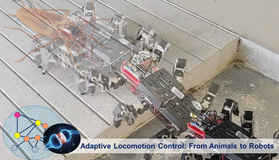-
1 Embodied AI: Design Principles of Intelligence
-
1.1 Introduction to Embodied AI
-
1.2 Properties of Embodied Agents
-
1.3 8 Design Principles for Embodied Agents Toward Embodied AI
-
2 Locomotion Principles in Animals
-
2.1 Biomechanics of Animals
-
2.2 Biological Neural Mechanisms for Animal Locomotion
-
2.3 Terminology for Locomotion
-
3 Biomechanics and Locomotion Control for Walking Robots
-
3.1 Biomechanics of Robots
-
3.2 Robot sensors for locomotion control
-
3.3 Locomotion control of walking robots
-
4 Neural Locomotion Control I
-
4.1 Central Pattern Generators (CPGs)
-
4.2 Frequency Adaptation for Locomotion Control
-
4.3 CPG implementation on robot simulation for locomotion control
-
5 Neural Locomotion Control II
-
5.1 Premotor Neural Networks for Directional and Gait Control
-
5.2 Velocity Regulating Network
-
5.3 Phase Switch Network
-
5.4 VRN implementation on robot simulation for directional control
-
6 Neural Sensory Preprocessing
-
6.1 Neurodynamics
-
6.2 Sensor-driven Behavior Control
-
6.3 Neural preprocessing implementation on robot simulation for autonomous obstacle avoidance
-
6.4 Recurrent Neural Networks
-
7 Learning and Adaptation for Adaptive Locomotion I
-
7.1 Correlation based Learning
-
7.2 Error-based Learning
-
7.3 Goal-direct behavior control
-
7.4 Robot learning implementation on simulation for adaptive behavior
-
8 Robot Intelligence Inspired by Nature
-
8.1 Hormone for Robot Adaptation
-
8.2 Multiple CPGs with Force Feedback for Self-Organized Locomotion
-
8.3 Bio-inspired Neural Control Applications
-
9 Installation Ubuntu and Lpzrobot simulation
